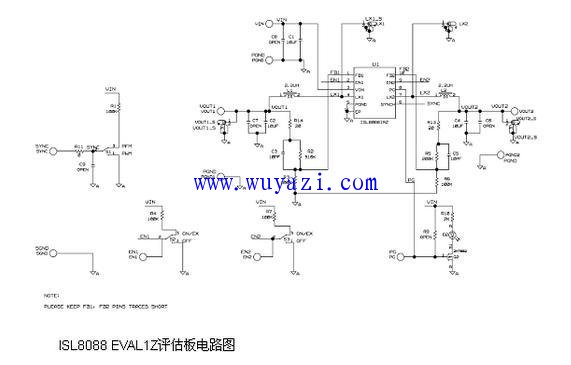Intersil's ISL8088 is a dual 800mA low quiescent current high efficiency 2.25MHz synchronous buck power regulator with a supply voltage from 2.75V to 5.5V and an operating frequency of 2.25MHz. Small, low cost inductors and capacitors are available, and each output voltage is available. As low as 0.6V, it is mainly used in DC/DC POL modules, μC/μP, FPGA and DSP power supplies, routers and switches for plug-in DC/DC modules, test and measurement systems, lithium-ion batteries and barcode readers. This article describes the main features of the ISL8088 and its application circuits, as well as the main features of the ISL8088 EVAL1Z evaluation board. 
The ISL8088 has user configurable operating mode PWM mode and PFM / PWM mode. Forcing PWM mode operation can reduce noise and RF interference and effectively reduce switching losses. In mode of operation, the channel draws a total quiescent current of only 30μa, thus making light load efficiency high in order to maximize battery life. The ISL8088 provides a monitor output that is rising. When closed, the ISL8088 discharges the output capacitor. Other features include an internal digital soft start that enables power sequencing, overcurrent protection, and thermal shutdown. The ISL8088 is available in a 3 mm x 3 mm 10 Ld DFN package and a maximum height of 1 mm. The complete converter footprint is less than 1.8 square centimeters.
ISL8088 EVAL1Z Evaluation Circuit Design The ISL8088 EVAL1Z kit is for personal use, with load point requirements for applications purchased from 2.75 v to 5.5 v. The ISL8088EVAL1Z evaluation board demonstrates the performance of the ISL8088 low quiescent current mode converter. The ISL8088 is available in a 3 mm x 3 mm 10 Ld DFN package and a maximum height of 1 mm. The complete converter footprint is less than 1.8 square centimeters. 
Key Features Power-Goods (PG) output 1 ms delay, 2.75 v to 5.5 v supply voltage, 3% output accuracy overheat / load / line, with Pre-biased start output, internal digital soft start - 2 ms, Soft-Stop Disabled during output discharge, 30μa quiescent supply current in ceramic mode, forced to force PWM mode and PFM mode, 4 mhz external synchronization, 6.5 typical μa logic control off current, maximum duty cycle of 100% minimum dropout, internal current compensation mode, Peak current limit, overheat protection.
Small computer system interface (SCSI) is an independent processor standard for system level interfaces between computers and intelligent devices (hard disks, floppy drives, optical drives, printers, scanners, etc.). SCSI is an intelligent universal interface standard.
1. SCSI can support multiple devices, SCSI-2 (fastscsi) can connect up to 7 SCSI devices, and widescsi-2 can connect 15 SCSI devices. In other words, all devices only need to occupy one IRQ. At the same time, SCSI also supports a wide range of devices, such as CD-ROM, DVD, CDR, hard disk, tape drive, scanner, etc.
2. SCSI also allows one device to transfer data and another device to look up its data. This can achieve higher performance in multitasking operating systems such as Linux and windows NT.
3. SCSI occupies a very low CPU, so it has obvious advantages in multitask system. Since the SCSI card itself has a CPU, it can handle all the transactions of SCSI devices. When the host CPU sends work instructions to the SCSI card, the SCSI card will work by itself. After the work is finished, the work results will be returned to the CPU. In the whole process, the CPU can carry out its own work.
4. The SCSI device is also intelligent. The SCSI card can queue CPU instructions by itself, which improves the work efficiency. In multitasking, the hard disk will be in the current head position, and the adjacent tasks will be completed first and then processed one by one.
5. The fastest SCSI bus has a bandwidth of 160MB / s, which requires the use of a 64 bit 66MHz PCI slot. Therefore, the maximum speed that can be achieved in the PCI-X bus standard is 80mb / s. if it is used with a dedicated hard disk with 10000rpm or 15000rpm, it will bring obvious performance improvement.
SCSI-180°DIP Section
ShenZhen Antenk Electronics Co,Ltd , https://www.antenksocket.com